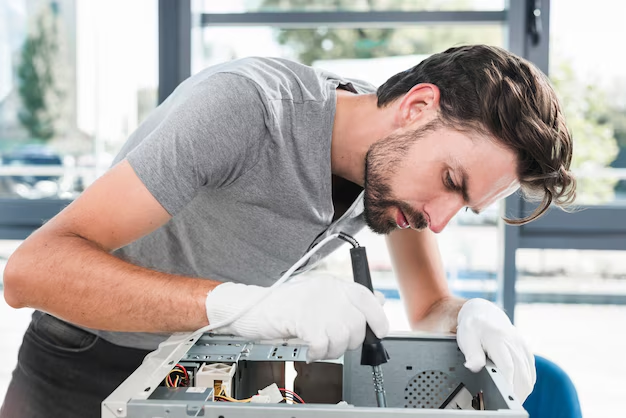Why Isn't My Refrigerator Cooling? Uncovering Common Causes and Solutions
Is your refrigerator acting more like a cabinet than a cooling appliance? You open the door, only to be greeted by lukewarm air instead of the refreshing chill you're used to. This can be a major inconvenience, especially when it threatens the freshness of your food and raises concerns about your appliance's performance. Let’s explore why your refrigerator might not be cooling and what steps you can take to remedy the situation.
Common Reasons Your Fridge Isn't Cooling
1. Dirty Condenser Coils
The condenser coils are often the first suspects when a refrigerator stops cooling efficiently. These coils, usually located at the back or beneath your appliance, release heat from the refrigerator. When coated in dust or debris, they can't dissipate heat effectively, leading to inadequate cooling.
How to Address:
- Clean the Coils: Unplug your refrigerator and move it away from the wall. Use a vacuum or special coil brush to gently clean the coils. Do this every six months to maintain performance.
2. Faulty Evaporator Fan
The evaporator fan circulates cold air from the coils throughout the refrigerator compartments. If this fan stops working, you might notice the freezer working properly, but the fridge itself remains warm.
Signs of a Problem:
- Strange noises from the freezer area.
- Uneven cooling or warm sections in the refrigerator.
How to Address:
- Check the Fan: Listen for the fan's operation when the door is closed. If silent, inspect for obstructions or call a professional to replace it.
3. Thermostat Settings
Sometimes, the simplest explanations are overlooked. Ensure that your fridge's temperature settings haven't been inadvertently adjusted.
How to Address:
- Check the Temperature: Set the refrigerator to the recommended setting, usually around 37-40°F (3-4°C), and the freezer to 0°F (-18°C).
4. Malfunctioning Compressor
The compressor is the heart of your refrigerator, pumping refrigerant through the coils. A faulty compressor can halt the entire cooling process.
Signs of a Problem:
- The refrigerator not making its characteristic humming sound.
- Food in the freezer beginning to thaw.
How to Address:
- Listen for Operation: If silent, consider calling a professional for a diagnosis. Compressors are complex and generally not a DIY fix.
5. Damper Control Issues
The damper controls air passage from the freezer to the fridge. If it's stuck, it can cause one section to be too cold or too warm.
How to Address:
- Inspect the Damper: Manually check the damper door and ensure it moves freely. Blocked airflow due to a stuck damper needs to be adjusted by a technician.
Additional Factors to Consider
6. Leaky Door Seals
If your refrigerator door seals (gaskets) are worn or damaged, warm air can enter, reducing cooling efficiency.
How to Address:
- Inspect and Replace Seals: Look for cracks or tears in the seals. Replacing them can usually be done as a DIY project or with the help of a professional.
7. Overpacked Refrigerator
Overfilling your fridge can block air vents, trapping cold air and causing uneven cooling.
How to Address:
- Rearrange Items: Leave space between items and ensure vents are unobstructed for proper airflow.
8. Location and Ventilation Issues
If your fridge is located too close to a heat source or doesn't have adequate space around it for ventilation, its efficiency can drop.
How to Address:
- Relocate Your Fridge: Ensure there is ample space for heat to dissipate around your refrigerator, typically 2 inches behind and an inch on each side.
9. Faulty Start Relay
Connected to the compressor, the start relay gives it the initial boost required to run. A faulty relay prevents the compressor from operating.
How to Address:
- Test the Relay: A burned smell or rattling sound when you shake it indicates a problem. Some retailers offer testing tools, or you may wish to consult a professional.
Table: Quick Fix Checklist for a Non-Cooling Fridge
| Issue | Solution |
|---|---|
| Dirty Condenser Coils | Clean every 6 months. |
| Faulty Evaporator Fan | Check for blockages or replace the fan. |
| Incorrect Thermostat | Reset to optimal temperatures: Fridge 37-40°F, Freezer 0°F. |
| Malfunctioning Compressor | Professional assessment recommended. |
| Damaged Door Seals | Inspect and replace seals as necessary. |
| Overpacked Fridge | Rearrange items to allow air circulation. |
| Poor Fridge Location | Ensure ample ventilation space around the appliance. |
| Faulty Start Relay | Check for smells/sounds, replace if necessary. |
When to Call a Professional
Not every refrigerator issue can be resolved with a simple DIY approach. Knowing when to call a professional can help save time and prevent further damage:
- Persistent Issues: If the problem persists after trying these solutions.
- Complex Repairs: Such as those involving the compressor or refrigerant lines.
- Electrical Concerns: If electrical components such as the control boards or wiring are suspect, for safety, a professional is recommended.
Final Insights
A refrigerator that isn’t cooling efficiently can be a frustrating issue, especially when it puts your food at risk. However, by understanding the common causes and solutions of these problems, you can often resolve the issue or make an informed decision about seeking professional help. Regular maintenance like cleaning coils and inspecting door seals can go a long way in maintaining your appliance’s performance.
By maintaining vigilance and acting quickly when issues arise, you can extend your refrigerator's lifespan and ensure your food remains fresh and safe. Assessing each component carefully not only saves money on potential repairs but also grants peace of mind knowing your appliance is running efficiently.
🔍 Always prioritize safety: If in doubt, seek professional assistance to avoid risking damage or injury. Remember, refrigerators are complex machines that require precision handling. Keep it cool, keep it efficient!
